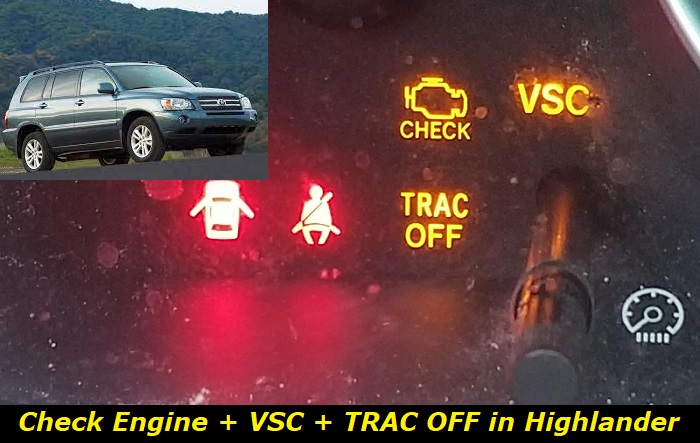You can reset warning lights like the Toyota Highlander check engine, VSC, and track-off lights. However, resetting the lights without addressing the underlying issue which caused the lights to pop up wouldn't be wise. The best way to tackle the situation would be to diagnose and fix the problem before resetting the lights. If you reset the lights without solving the issues, the lights may illuminate once again.
Traction Control Off light highlights
- Common reasons:issues in traction control function
- How to fix:disconnect the battery for some time, read the codes
- Possible consequences:vehicle's behavior may change
- Priority level:High
- Can you drive?Carefully
- DIY repair:Impossible
- Repair price range:$200-$850

Understanding These Warning Lights
Before resetting these warning lights, you need to understand what these warning lights mean and the implications of these warning lights. Each of these lights serves a purpose, and understanding why the Toyota Highlander check engine, VSC, and trac off is vital for the vehicle's safety and performance.
1) Check Engine Light
Indicated by an engine icon, the check engine light can illuminate due to a variety of different reasons related to the engine, emission, or exhaust systems. If your check engine light is illuminated, there is a good chance that there is something wrong with your Toyota Highlander.
It is a warning light, so it does pop up at the early stages of the problem. So, you might be able to continue driving and you might not even feel anything out of the ordinary with your vehicle. But ignoring this warning light without getting it checked out will surely lead to significant problems.
2) VSC Light
The acronym VSC stands for Vehicle Stability Control. The VSC Light, represented by an icon of a car skidding, indicates that the Vehicle Stability Control system has been engaged or is experiencing difficulties. VSC is a safety feature on your Toyota Highlander that is designed to prevent skidding and losing control when the roads get slippery.
So, how does the VSC work? The VSC collects data from various sensors like the wheels speed sensor, steering angle sensor, etc... The ECU then proceeds to break down this data in real time. If the ECU detects that the vehicle is deviating from its intended path, like if the rear wheels slide lose traction and slide away from the vehicle during an oversteer, the VSC will engage and stabilize the vehicle. It does so by applying the brakes on individual wheels as needed.
If the VSC warning light is illuminated, it could indicate a malfunction with the system. This means that your Highlander is more susceptible to instability and loss of traction.
3) Trac Off Light
The Trac Off Light, typically depicted as the word "TRAC OFF" or an icon with "TRAC OFF," signifies that the Traction Control System has been deactivated or is experiencing issues. The Traction Control System enhances stability and control during acceleration.
The Traction Control System, just like the VSC also depends on sensors. The data from the sensors is then read by the ECU. When your Highlander accelerates, the ECU monitors the rotational speed of each wheel. If one or more wheels spin faster than the rest, the ECU interprets it as a loss of traction.
Then the Traction Control System regains control by reducing the engine power and applying the brakes on the wheels that are skidding and increasing the torque on the wheels that have traction, thus allowing you to regain stability. The Traction Control System works in harmony with the VCS, so it is common for both warning lights to illuminate simultaneously.
If the Trac Off light is illuminated, it means that the Traction Control System is not active. Which increases the risk of wheel spin and loss of control.
Why are all these lights on in my Highlander?
These lights should be one for some seconds when you start the car. But then they should go off one by one. If the check engine light, the VSC and the TRAC OFF lights are on the dash after you started the car, there is a problem. But in the Highlander, it's very common that the VSC and the TRAC OFF lights will just accompany the check engine light. So, you just need to solve the problem triggering the check engine light. And then, everything will be fine.
For this, you will need to read the code that sits behind the check engine light and solve the problem that triggered that code. It may be anything from a faulty sensor in the engine to the loose gas cap or something like that.
Can You Reset the Warning Lights?
Resetting these warning lights in your Toyota Highlander is possible, but proceed with caution. Again, resetting the check engine light, VSC light, and the Trac Off is not a fix, so you need to find out the underlying issue which caused these warning lights to illuminate.
1) Resetting The Warning Lights
Resetting the warning lights is not as complicated as you think, and all you need is an OBD2 scanner. Have your Highlander parked in a safe place before starting the procedure. The next step is to locate the OBD2 port. Typically, you can find this right under your dash on the driver's side.
Now connect your OBD2 scanner to your Highlander through the port. Once it is secured, you need to switch on the vehicle but do not start the engine. Resetting the light depends on the scanner you use, but if you follow the instructions, it is a simple procedure.
But before you reset the codes, make sure to jot down the error codes displayed on the scanner. These error codes are what will allow you to diagnose the problem which illuminated the lights in the first place. Now cross-reference these codes with your user's manual and you should be able to find out the problem.
2) Consequences Of Resetting The Codes Without Addressing The Issue
Let's say you forgot to screw on your gas cap after refueling. Even something as simple as this is enough to cause your check engine light to illuminate. And once you screw the cap back on, the check engine light is not going to disappear. So, in a situation like this, resetting the warning lights is totally justified. But the cause of concern occurs when the lights pop up once again after resetting.
Resetting the light doesn't fix the underlying issue. So resetting is not a solution. As long as the problem persists, the light will come on again and again. Plus, resetting these lights without solving the issue is also a safety hazard. Be it the check engine light, VSC light, or the Trac Off light, they all indicate an issue with your vehicle. Ignoring warning lights can pose safety risks, as they may indicate critical issues affecting vehicle performance, emissions, or stability. And the longer these problems linger in your vehicle the worse it gets. So as the damage intensifies, so will the cost that goes into getting the repairs done.
So, before attempting any reset, identifying the underlying issue is vital. If the lights were triggered due to minor issues, such as a loose gas cap, resolving the problem and resetting the lights may be appropriate. However, if the lights were activated by more significant problems, such as a malfunctioning sensor or emission system issue, professional diagnosis, and repair are necessary.
When To Seek Professional Help?
You might have an OBD2 scanner in hand, but that is not enough. Some problems you can't fix on your own. If you face any of the following issues with your warning lights, it is recommended that you seek professional help.
1) Persistent Warning Light
If the warning light keeps reappearing, then you might have to seek professional expertise. You might have tried a DIY fix and proceeded to reset the codes, but if the problem wasn't effectively resolved, the warning lights will illuminate again and again until it is solved.
2) Flashing Check Engine Light
What is the difference between a solid-lit check engine light and a flashing check engine light? When it is flashing, it indicates a severe problem with the engine. Usually, this happens when you continue driving ignoring the check engine light. Unfortunately, there is no other step after the flashing check engine light, if you ignore the problem this time, your Highlander will break down and stall. So, it is recommended to go to a mechanic and get the problem sorted out before further damage is done to the engine.
3) Reduced Performance / Emission Failures
If you notice performance issues with your Highlander such as rough idling, decreased acceleration, or decreased fuel efficiency, along with the check engine light, it indicates a problem that needs to be sorted out as soon as possible. Similarly, if your vehicle fails an emission test while your check engine light is on, chances are you've got a problem with your emission or exhaust system. Either way, you should seek professional help and take the necessary steps to get the warning lights resolved.
4) VSC Or Trac Off Light
Whenever one of these lights illuminates, it is often related to sensors. These systems rely on numerous sensors within your vehicle and even if one of these sensors fails, you are going to get these warning lights. These repairs are quite complicated and difficult to attempt without the right set of tools. So, it is better to leave it to the professionals. And since it is related to the stability and control of the vehicle, don't ignore the lights as it might pose a safety hazard.
How To Avoid Getting These Warning Lights?
It is not exactly possible to avoid these warning lights as a Toyota Highlander owner, you are bound to run into these sooner or later. But there are certain steps you can take in the right direction to reduce the probability. Make sure to have an optimal level of engine oil at all times, inspect fluid levels regularly and get them replaced if needed, replace filters according to the maintenance schedule, and use the right type of fuel. Simple acts such as these can go a long way in terms of keeping your vehicle healthy.
About the authors
The CarAraC research team is composed of seasoned auto mechanics and automotive industry professionals, including individuals with advanced degrees and certifications in their field. Our team members boast prestigious credentials, reflecting their extensive knowledge and skills. These qualifications include: IMI: Institute of the Motor Industry, ASE-Certified Master Automobile Technicians; Coventry University, Graduate of MA in Automotive Journalism; Politecnico di Torino, Italy, MS Automotive Engineering; Ss. Cyril and Methodius University in Skopje, Mechanical University in Skopje; TOC Automotive College; DHA Suffa University, Department of Mechanical Engineering






Add comment